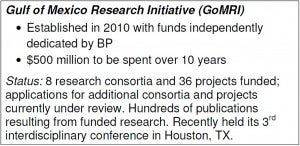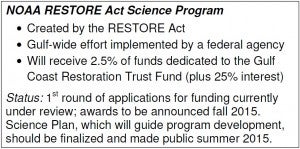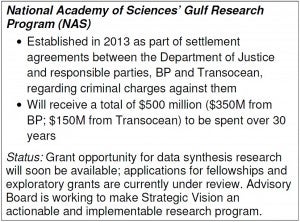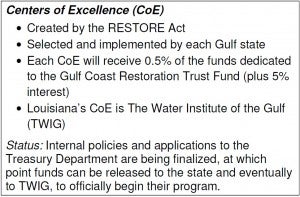Following the oil spill, new science and research efforts develop in the Gulf of Mexico
By Estelle Robichaux, Restoration Project Analyst, Environmental Defense Fund
This is the final post in a series about Gulf oil spill early coastal restoration funding and projects. Be sure to check out parts one, two and three.
In addition to environmental restoration projects and programs, four different science programs have been created through oil-spill related funding streams. See the info boxes for details on each program.
Because these programs began developing around the same time and around the same general topics – the Gulf of Mexico, ecosystem restoration and oil and gas production – there is often a lot of confusion about what these programs do and how they are different. We are here to help!
How are the areas of focus in each of these science programs different?
There are three broad areas of focus that all of these programs collectively address:
- Ecosystems & the environment
- The human element
- Offshore oil development & the environment
However, there are key distinctions between each program and how they address these broader topics.
Ecosystems & the environment
Based on the statutory language in the RESTORE Act, the National Oceanic and Atmospheric Administration (NOAA) science program covers all marine and estuarine ecosystems in the Gulf of Mexico. The Centers of Excellence (CoE) programs are more narrowly focused on coastal and deltaic systems. Both of these programs also include fisheries, with CoE programs being limited to coastal fisheries but also covering coastal wildlife.
The National Academy of Sciences (NAS) program broadly addresses protection of environmental resources, while the Gulf of Mexico Research Initiative (GoMRI) does not have a directive to concentrate on specific ecosystems or species.
GoMRI does, however, have an explicit focus on ecosystem recovery. The CoE programs can emphasize ecosystem restoration and sustainability, and NAS has interpreted language in the settlement agreements to include restoration of the environment and ecosystem services under their program as well.
The NOAA program is supposed to support ecosystem sustainability and restoration “to the maximum extent practicable.” There is a focus on ecosystem management in the current science plan, but this program is not specifically designed around restoration science.
The human element
The BP oil disaster also has had a great impact on human communities. Both the NAS program and GoMRI are investigating human and public health issues that have developed in the wake of the spill. This includes socioeconomic research as well as behavioral, mental and social well-being. CoE programs can address economic and commercial development in the Gulf region, with a focus on sustainable and resilient growth.
Offshore oil development & the environment
Throughout the Gulf Coast and particularly in Louisiana, the oil and gas industry is an important economic driver and employer. But offshore oil and gas production needs to be done responsibly, for both the people and environment of the Gulf.
Safe and sustainable offshore energy development is something on which CoEs can focus. The NAS program is will be addressing oil system safety and GoMRI will be developing technology related to oil spill response and remediation.
GoMRI’s primary focus is on the impacts of oil and dispersants on Gulf ecosystems and organisms as well as the physical and chemical questions surrounding oil and dispersants, such as where did the oil go and how has the oil and dispersants been degrading.
Are all of these programs investing the same kinds of science?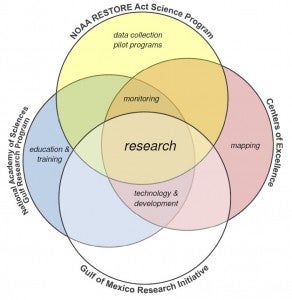
As with the areas of focus, there is a lot of overlap in the types of science activities that these programs are targeting, but there are a few important differences.
The obvious commonality among all four programs is research, which is not surprising as they are all science-focused endeavors.
GoMRI, CoEs and the NAS program also all have some focus on technology and development. This means that some of the science and research that these programs fund will be targeted towards developing new technologies, products or procedures.
The NOAA and NAS programs, as well as CoEs, will invest in monitoring. As discussed in this previous blog post, the BP oil spill highlighted the lack of coordinated, comprehensive monitoring throughout the Gulf region. These programs will fund research into what monitoring does exist throughout the Gulf and explore options and opportunities for implementing monitoring programs.
Even among the distinguishing types of activities these programs will pursue, there are areas of convergence. The NAS program has a mandate to focus on education & training; CoEs on mapping the Gulf of Mexico; and the NOAA program on data collection and fisheries pilot programs. However, training and pilot programs may find overlap with development initiatives. Similarly, data collection and mapping are both important activities strongly related to monitoring. With so many intersections between and among programs, it is essential that these programs communicate with one another.
What’s missing?
With everything these four science programs are doing, it may be hard to believe that anything is lacking. But there are two very important things missing from these collective efforts.
One is formal coordination among programs. Over the last few years, as these programs have begun developing, there has been copious discussion about not duplicating efforts among programs. However, there has been little conversation about devising specific, formal coordination mechanisms to make sure that such duplication does not happen.
Development and implementation of formal coordination mechanisms would also allow programs to take advantage of overlap, by providing points of discussion for complementary or parallel endeavors, particularly those that might span ecosystem boundaries or involve large-scale research or monitoring.
The second missing piece is a means for integrating findings into restoration activities, like those discussed here. Although this will require work beyond the four programs examined here, these science programs should make every effort to ensure that results from their funded research and activities are publicly accessible and readily communicated to decision-makers.
These science programs may not be constructing restoration projects, but the results from their research and other activities may have important implications for restoration efforts now and in the future.
